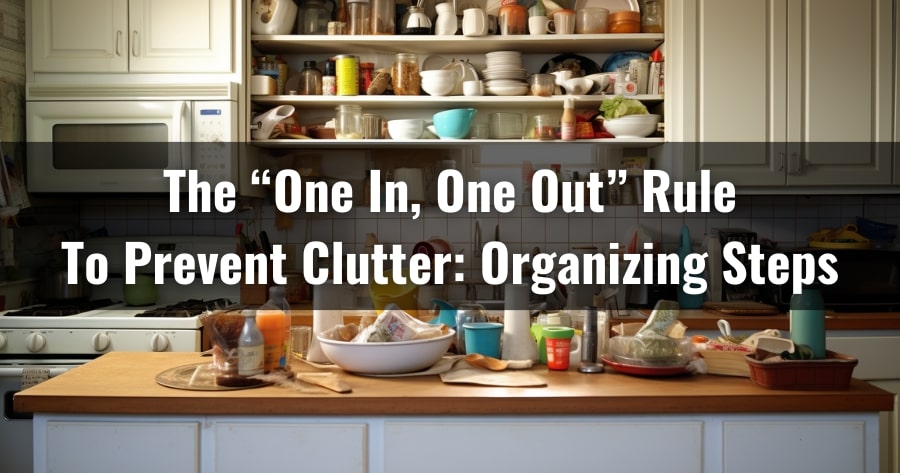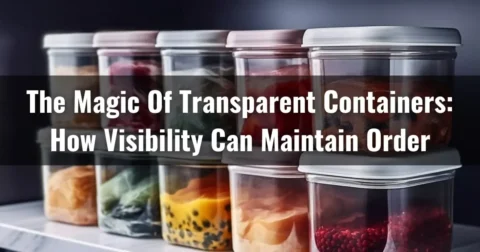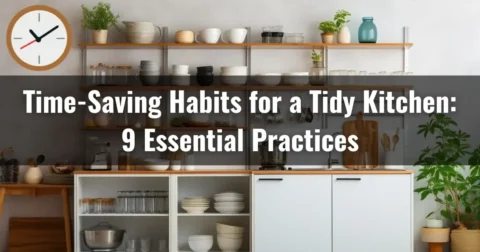Kitchen clutter is a significant issue that can reduce your cooking efficiency. If your kitchen counters and cabinets are cluttered with too many things, there is a solution to this problem. When organizing, you can implement the “One In, One Out” rule to prevent your kitchen clutter.
This rule is simple yet efficient in preventing clutter from accumulating. It encourages conscious decision-making about essential items and promotes sustainable and conscious consumption. Implementing the rule also ensures a streamlined and efficient food preparation process.
As part of this article, we will explore how you can implement this rule in your daily kitchen routine. So, keep reading and prepare to declutter and make space for what truly matters in your culinary haven.
Jump to Section
How Do You Implement the “One In, One Out” Rule to Prevent Kitchen Clutter?
Utensils, gadgets, and cookware can quickly accumulate, turning the kitchen area into chaos.
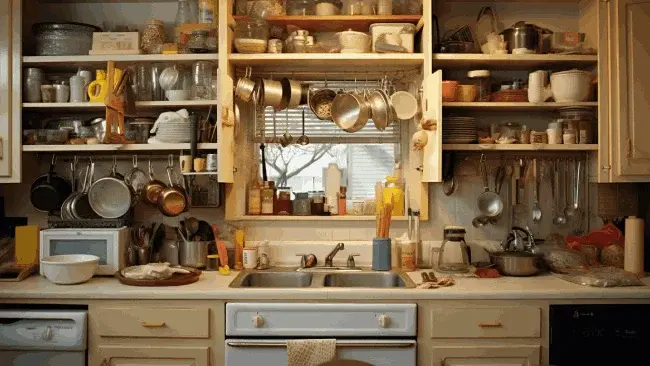
So, you must follow the systematic approach listed below to implement the ‘One In, One Out’ rule and minimize kitchen clutter.
- Assess your current inventory
- Define your priorities
- Implement the systematic approach
- Donate or repurpose unneeded items
- Set clear guidelines
- Regular maintenance and reflection
Step 1: Assess Your Current Inventory
Assess your current inventory to effectively enforce the ‘One In, One Out’ rule and prevent kitchen clutter.
Start by emptying your cabinets, drawers, and countertops to get a clear view of all your utensils, appliances, and cookware. This allows you to identify items that may no longer serve a purpose in your kitchen.
Take note of duplicates or items that you rarely use. This sets the foundation for a clutter-free kitchen, ensuring every item has a purpose and a designated space.
Step 2: Define Your Priorities
Prioritize your essential and regularly used items in the kitchen to implement the rule effectively and prevent kitchen clutter. Consider your cooking habits, lifestyle, and the available space in your kitchen. Define what items are essential and regularly used versus those seldom or never used.
Step 3: Implement the Systematic Approach
Identifying an existing item you’re willing to part with when bringing in a new item, following the ‘One In, One Out’ rule to prevent kitchen clutter. This approach ensures that you maintain a well-organized and efficient kitchen space.
By consciously choosing which items to let go of, you can make room for new additions that serve your needs and add value to your kitchen. Consider the functionality, necessity, and frequency of use when deciding what to keep and let go of.
Step 4: Donate or Repurpose Unneeded Items
For a clutter-free kitchen, you can donate unneeded items. Instead of simply discarding them, donating to a local charity or finding creative ways to repurpose them can be a sustainable solution.
For example, old utensils can be transformed into unique crafting projects, adding a creative touch to your home decor. Similarly, functional appliances that are no longer needed can benefit someone in need.
Step 5: Set Clear Guidelines
Communicate and consistently enforce the guidelines for what constitutes a new item in your household. Without clear guidelines, it can be difficult to determine whether an item should be considered as part of the ‘One In, One Out’ rule.
One way to establish these guidelines is to define what qualifies as a new item. This can include purchases, gifts, or replacements for worn-out items. By clearly defining what constitutes a new item, you can ensure that everyone in your household understands the criteria.
Another important step is ensuring everyone in your household understands these guidelines and agrees to follow them. This can involve discussing the importance of maintaining a clutter-free kitchen with family members or roommates.
Step 6: Regular Maintenance and Reflection
Schedule regular maintenance sessions to assess your kitchen. These sessions should be set aside each month for reflection and evaluation.
Take the time to consider what’s working well in your kitchen, what could be improved, and whether your priorities or cooking habits have changed. During these sessions, evaluate the items in your kitchen and determine if any need to be donated or repurposed.
What are the Fundamentals of a “One In, One Out” Rule to Prevent Kitchen Clutter?
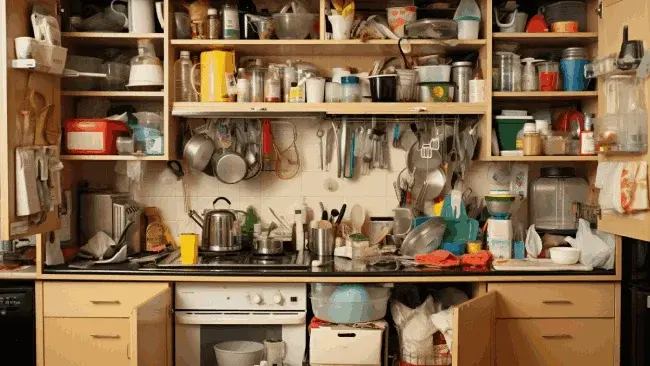
The fundamentals of a ‘One In, One Out’ rule in preventing kitchen clutter are centered around several key points.
1. Simplicity and Efficiency
Adopting the rule simplifies your kitchen while ensuring efficient and clutter-free food preparation. The fundamentals of this rule revolve around the principles of simplicity and efficiency.
2. Preventing Accumulation
This rule requires you to consistently remove one kitchen item for each new item you bring in. By adhering to this rule, you’re forced to evaluate the necessity and usefulness of each new item before bringing it into your kitchen.
3. Forcing Prioritization
When implementing the rule, prioritize by evaluating the importance and utility of each new kitchen item before adding it to your space. Doing so forces you to make conscious decisions about what supplies are essential and worth keeping in your kitchen.
This prioritization process helps prevent clutter and ensures that you only make room for items that serve a purpose and add value to your cooking and food preparation.
4. Maintaining Order
To comply with this rule, consider whether the new item will improve your cooking experience or add to the clutter. By implementing this rule, you can ensure that your kitchen remains organized and efficient.
Take the time to assess your kitchen tools and utensils, and identify any items that are no longer useful or necessary.
5. Sustainability and Conscious Consumption
Implementing the ‘One In, One Out’ rule promotes sustainable and conscious consumption by ensuring that each new kitchen item replaces an existing one. This rule encourages individuals to think twice before purchasing new items and consider whether they need them.
By adopting this mindset, you’re actively reducing unnecessary clutter and waste in your kitchen. The rule encourages you to prioritize and make conscious choices about what you bring into your kitchen space.
FAQ’s
What is the first rule of kitchen decluttering?
Before you begin decluttering your kitchen, adhere to the first rule: bring in new items only when you remove something old. By following this rule, you ensure that the number of items in your kitchen remains constant, preventing the accumulation of unnecessary clutter.
It forces you to make thoughtful decisions about what items are essential and eliminates the tendency to hoard items that are seldom used.
Can I simplify meal preparation using the “One In, One Out” rule?
You can simplify meal preparation by applying the ‘One In, One Out’ rule. By following this rule, you can streamline your cooking process and make it more efficient.

When you bring in a new ingredient or kitchen tool, make a point to remove something of equal value or functionality. This ensures that your kitchen remains clutter-free and organized, allowing you to access the tools and ingredients easily.
With a simplified and streamlined kitchen, you can save time and effort during meal preparation, as everything will be easily accessible and in its rightful place. The rule is a simple yet effective strategy to maintain a clean and efficient kitchen, making your cooking experience more fun and stress-free.
Conclusion
Applying the ‘One In, One Out’ rule in your kitchen can be a simple and effective way to prevent clutter.
Don’t forget to assess your current inventory, establish your priorities, establish clear guidelines, implement a systematic approach, and regularly donate or repurpose items that are no longer needed.
With patience, conscious decision-making, and regular upkeep, you can transform your cluttered kitchen into a functional and stress-free space.
We hope this article has helped you understand the fundamentals of the rule to prevent kitchen clutter.


